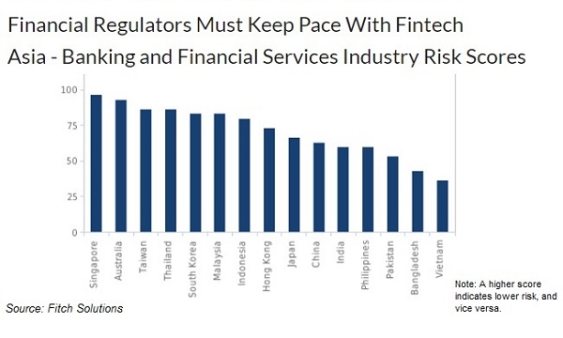
Chart of the Week: Systemic risks still weighing on Asia's fintech markets
Even the world’s biggest fintech market, China, suffers from substantial industry risk.
Regulators must find balance between managing systemic risk in Asia’s booming financial technology (fintech) market and allowing the segment to “grow organically,” according to Fitch Solutions.
More than half of the markets studied by Fitch Solutions still fall below 75 points in the industry risk scores. A higher score indicates lower risk, and vice versa.
Amongst the high-risk countries is China, the world’s biggest fintech market, who despite enjoying a robust online payments segment has not escaped the sudden burst of related segments. This was said to be evidenced by the boom and bust of the P2P lending scheme in the country, which rapidly grew from only 50 in 2011 to 3,500 in 2016. However, a survey by the Chinese Banking Regulatory Commission later revealed that about 40% of these were in fact Ponzi schemes. The ensuing tighter regulations from the government led to thousands of P2P platforms closing up by the end of 2016.
“The relative lack of supervision in the fintech sector in the early days of development had allowed many companies to trial and launch their services with few regulatory constraints. However, this subsequently led to the growth of systemic risk; the boom and bust of the P2P lending segment in China was one key instance. Regulators will increasingly need to find a balance between managing systemic risk and allowing the segment to grow organically,” reported Fitch Solutions.
As a result, central banks and financial regulators have become more proactive when it comes to the fintech sector. They have reportedly been studying the market extensively and introducing new regulations to manage growth and risk in emerging segments such as P2P lending and digital currencies.
“Besides introducing greater supervision over the segment, several financial regulators are also offering incentives, such as tax breaks for banks to invest in businesses engaged in tech, as well as grants for fintech companies with a successful use-case,” added Fitch Solutions, although they noted that these were largely limited to developed markets with substantial fiscal surpluses.
Meanwhile, countries with the lowest risk include Singapore, Australia, Taiwan, and Thailand.






















 Advertise
Advertise








